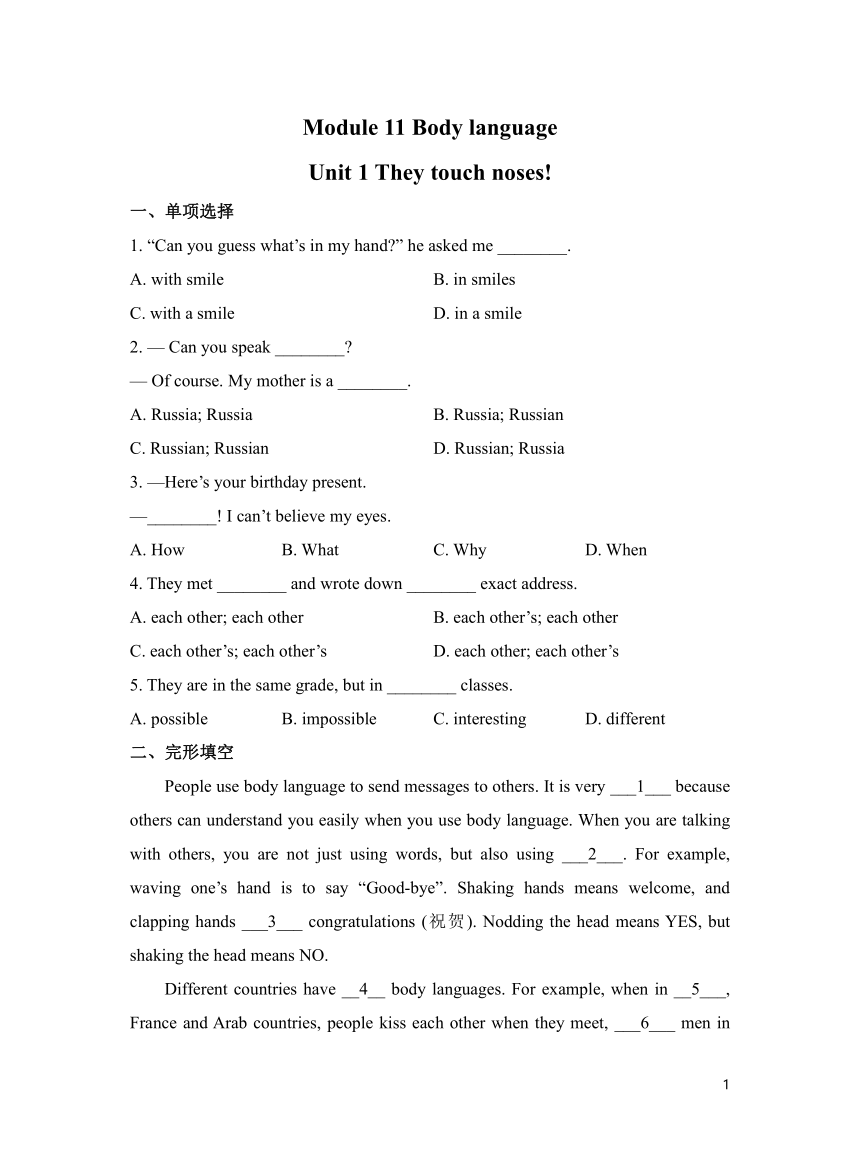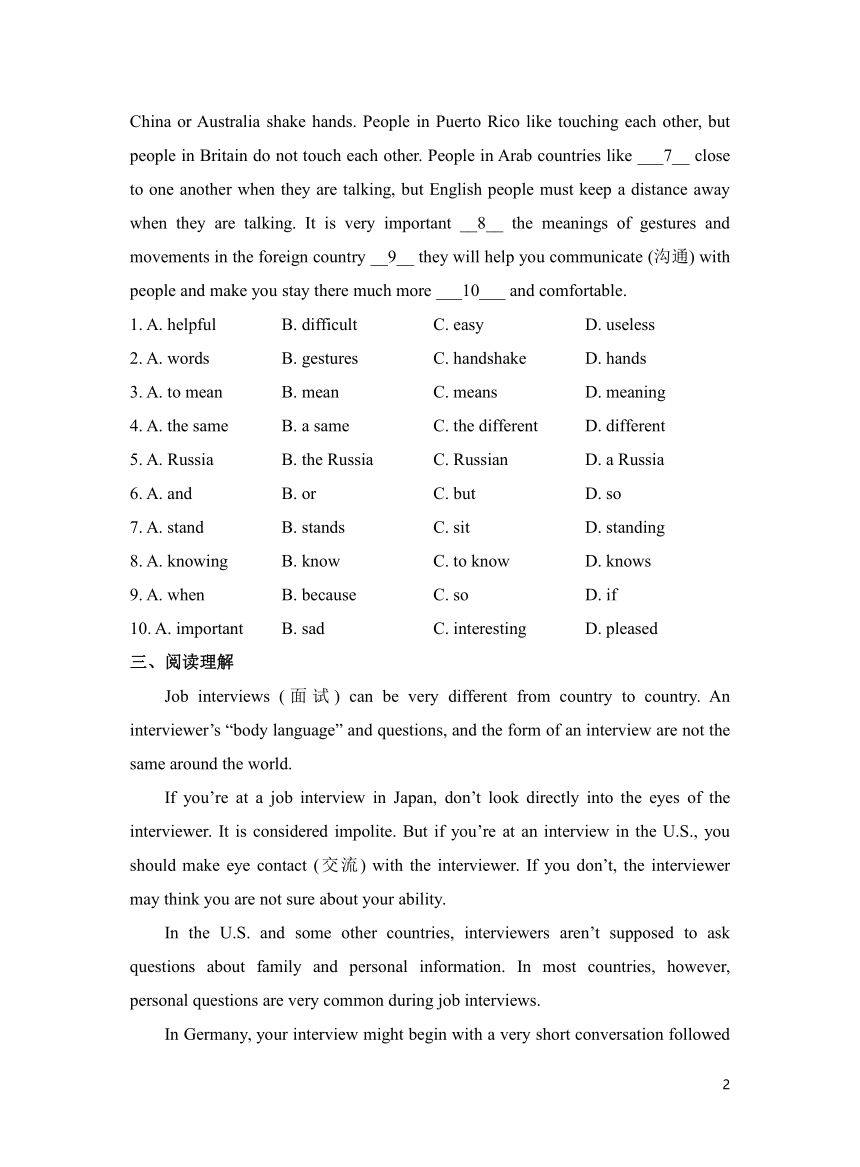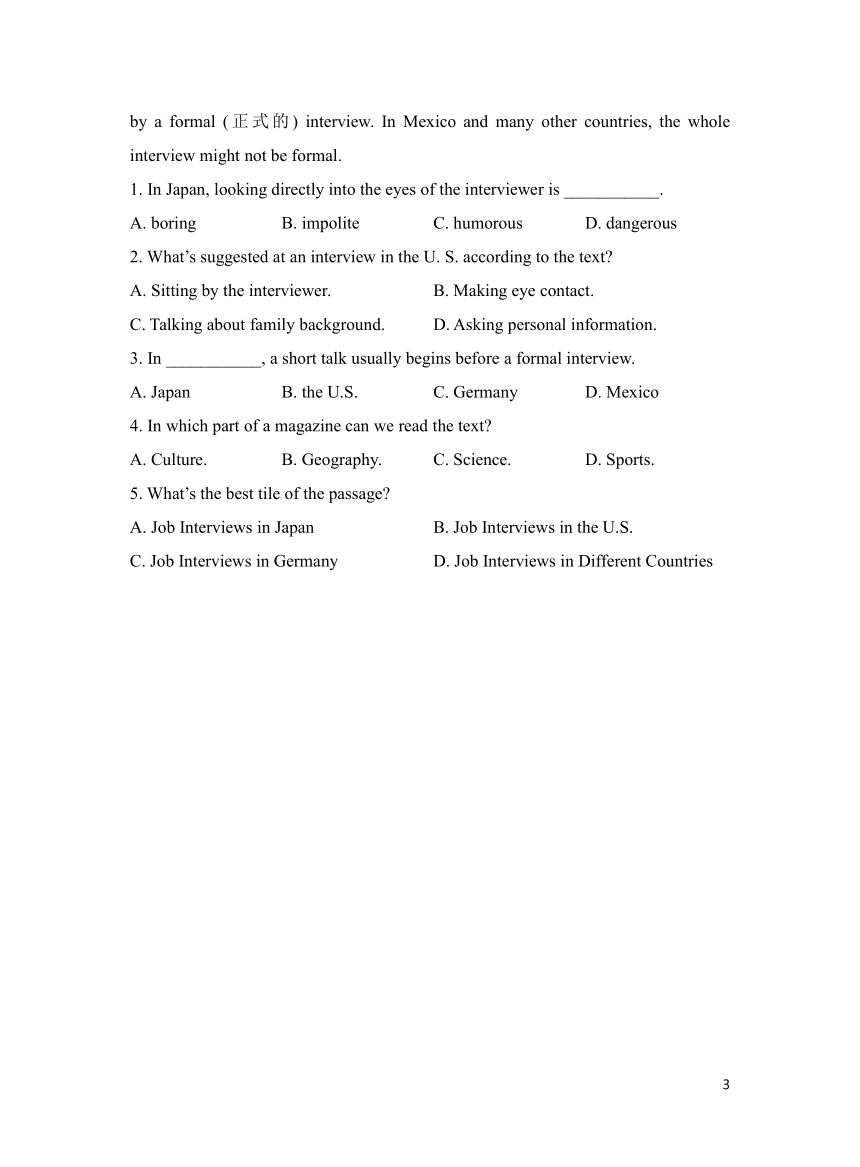Module 11 Body language Unit 1 They touch noses!作业(含解析)
文档属性
| 名称 | Module 11 Body language Unit 1 They touch noses!作业(含解析) |

|
|
| 格式 | doc | ||
| 文件大小 | 42.5KB | ||
| 资源类型 | 教案 | ||
| 版本资源 | 外研版 | ||
| 科目 | 英语 | ||
| 更新时间 | 2023-08-30 16:17:00 | ||
图片预览



文档简介
Module 11 Body language
Unit 1 They touch noses!
一、单项选择
1. “Can you guess what’s in my hand ” he asked me ________.
A. with smile B. in smiles
C. with a smile D. in a smile
2. — Can you speak ________
— Of course. My mother is a ________.
A. Russia; Russia B. Russia; Russian
C. Russian; Russian D. Russian; Russia
3. —Here’s your birthday present.
—________! I can’t believe my eyes.
A. How B. What C. Why D. When
4. They met ________ and wrote down ________ exact address.
A. each other; each other B. each other’s; each other
C. each other’s; each other’s D. each other; each other’s
5. They are in the same grade, but in ________ classes.
A. possible B. impossible C. interesting D. different
二、完形填空
People use body language to send messages to others. It is very ___1___ because others can understand you easily when you use body language. When you are talking with others, you are not just using words, but also using ___2___. For example, waving one’s hand is to say “Good-bye”. Shaking hands means welcome, and clapping hands ___3___ congratulations (祝贺). Nodding the head means YES, but shaking the head means NO.
Different countries have __4__ body languages. For example, when in __5___, France and Arab countries, people kiss each other when they meet, ___6___ men in China or Australia shake hands. People in Puerto Rico like touching each other, but people in Britain do not touch each other. People in Arab countries like ___7__ close to one another when they are talking, but English people must keep a distance away when they are talking. It is very important __8__ the meanings of gestures and movements in the foreign country __9__ they will help you communicate (沟通) with people and make you stay there much more ___10___ and comfortable.
1. A. helpful B. difficult C. easy D. useless
2. A. words B. gestures C. handshake D. hands
3. A. to mean B. mean C. means D. meaning
4. A. the same B. a same C. the different D. different
5. A. Russia B. the Russia C. Russian D. a Russia
6. A. and B. or C. but D. so
7. A. stand B. stands C. sit D. standing
8. A. knowing B. know C. to know D. knows
9. A. when B. because C. so D. if
10. A. important B. sad C. interesting D. pleased
三、阅读理解
Job interviews (面试) can be very different from country to country. An interviewer’s “body language” and questions, and the form of an interview are not the same around the world.
If you’re at a job interview in Japan, don’t look directly into the eyes of the interviewer. It is considered impolite. But if you’re at an interview in the U.S., you should make eye contact (交流) with the interviewer. If you don’t, the interviewer may think you are not sure about your ability.
In the U.S. and some other countries, interviewers aren’t supposed to ask questions about family and personal information. In most countries, however, personal questions are very common during job interviews.
In Germany, your interview might begin with a very short conversation followed by a formal (正式的) interview. In Mexico and many other countries, the whole interview might not be formal.
1. In Japan, looking directly into the eyes of the interviewer is ___________.
A. boring B. impolite C. humorous D. dangerous
2. What’s suggested at an interview in the U. S. according to the text
A. Sitting by the interviewer. B. Making eye contact.
C. Talking about family background. D. Asking personal information.
3. In ___________, a short talk usually begins before a formal interview.
A. Japan B. the U.S. C. Germany D. Mexico
4. In which part of a magazine can we read the text
A. Culture. B. Geography. C. Science. D. Sports.
5. What’s the best tile of the passage
A. Job Interviews in Japan B. Job Interviews in the U.S.
C. Job Interviews in Germany D. Job Interviews in Different Countries
参考答案与解析
一、单项选择
1. C
【解析】句意:他面带微笑地问我:“猜到我手里拿着什么吗?”
考查介词短语,smile微笑,可数名词,一般用的是with a smile表示面带微笑。分析句意,此处表述的是他面带微笑地问我。故选C。
2. C
【解析】句意:——你会说俄语吗?——当然会了。我妈妈就是俄罗斯人。
考查名词的用法辨析。Russia意为“俄罗斯”,指国家;Russian可用作名词,意为“俄语;俄罗斯人”。根据句意故选C。
3. B
【解析】句意:——这是你的生日礼物。 ——什么!我不敢相信我的眼睛。
考查情景交际用语,How怎样(通常询问方式);What什么;Why为什么(询问原因);When什么时候(询问时间)。根据“I can’t believe my eyes.”可知自己很是吃惊,用what!什么!表示惊讶,符合场景,且意思完整。故选B。
4. D
【解析】句意:他们遇到了彼此,写下了彼此确切的地址。
each other彼此;each other’s彼此的。分析句意,第一个空表示“彼此”。用each other。第二个空表示“彼此的”用所有格形式,表示后面的exact address隶属于他们。所以第二个空填each other’s。故选D。
5. D
【解析】句意:他们在同一年级,但在不同的班。
考查形容词辨析,possible可能的;impossible不可能的;interesting有趣的;different不同的。分析句意,并结合but,,可知后半句表示他们在不同的班。第二空后面是名词复数,用形容词different作定语修饰后面的名词。故选D。
二、完形填空
【解析】本文讲述了不同国家有不同的肢体语言。在外国知道手势和动作的含义是很重要的,因为它们帮助你进行交流并且让你更加快乐、更加舒服地待在那里。
1. A 句意:它是非常有帮助的,因为当你使用肢体语言时,其他人会轻松地明白你。
A. helpful有帮助的,B. difficult困难的,C. easy容易的,D. useless无用的。根据because others can understand you easily when you use body language.可知,使用肢体语言可以让别人轻松明白你的话,所以它是有帮助的。故选A。
2. B 句意:当你和别人说话时,不仅使用语言,还会用到手势。
A. words 单词,B. gestures姿势,C. handshake握手,D. hands手。根据后文的For example, waving one’s hand is to say “Good-bye”.可知,挥手说再见,故这是手势,故选B。
3. C 句意:握手意味着欢迎,鼓掌意味着祝贺。
A. to mean意味着,是动词不定式;B. mean意味着,是复数形式;C. means 意味着,是第三人称单数形式;D. meaning意味着,是动名词;此处动名词短语clapping hands作主语,故谓语用第三人称单数形式,故选C。
4. D 句意:不同国家有不同的肢体语言。
A. the same同样的,B. a same同样的,C. the different不同的东西,D. different不同的。由下文可知,不同的国家有不同的肢体语言。根据后文的For example, when in ___5___, France and Arab countries, people kiss each other when they meet, ___6___ men in China or Australia shake hands.可知,不同的国家有不同的手势,different意为“不同的”,且前面不加定冠词the。故选D。
5. A 句意:例如,在俄国,法国和阿拉伯国家,人们见面是互相亲吻,但是在中国或者澳大利亚的男人握手。
A. Russia俄国,B. the Russia那个俄国,C. Russian俄国人,D. a Russia一个俄国。此处需要选择表示“国家”的词,且专有名词前不加冠词。故选A。
6. C 句意:例如,在俄国,法国和阿拉伯国家,人们见面是互相亲吻,但是在中国或者澳大利亚的男人握手。
A. and而且,B. or或者,C. but但是,D. so所以。前后两个分句的意思是相反的,所以选择表示转折的并列连词。故选C。
7. D 句意:阿拉伯国家的人喜欢说话时彼此站得非常近,但是人在说话时应该保持一定距离。
A. stand站立,复数形式;B. stands站立,是第三人称单数形式;C. sit坐,是复数形式;D. standing站立,是现在分词。like后面接动词-ing形式。故选D。
8. C 句意:在外国知道手势和动作的含义是很重要的,因为它们帮助你进行交流并且让你更加快乐、更加舒服地待在那里。
A. knowing知道,是现在分词;B. know知道,是复数形式;C. to know知道,是动词不定式;D. knows知道,是第三人称单数形式。It’s+形容词+to do sth.“做某事是……”it是形式主语,to do sth.真正主语。故选C。
9. B 句意:在外国知道手势和动作的含义是很重要的,因为它们帮助你进行交流并且让你更加快乐、更加舒服地待在那里。
A. when当……时候;B. because因为;C. so所以;D. if如果。结合句意,前后两句之间是因果关系,后半句表示原因。故选B。
10. D 句意:在外国知道手势和动作的含义是很重要的,因为它们帮助你进行交流并且让你更加快乐、更加舒服地待在那里。
A. important重要的,B. sad悲伤的,C. interesting有趣的,D. pleased高兴的。根据语境可知,知道外国的手势和动作的含义,这样住在那里会更高兴,故选D。
三、阅读理解
【解析】各个国家面试方式各不相同。在日本接受工作面试,不要直视面试官的眼睛,这被认为是不礼貌的;在美国面试,应该和面试官进行眼神交流;在美国和其他一些国家,面试官不应该询问关于家庭和个人信息的问题。在德国,面试可能从一个非常简短的谈话开始。
1. B 细节理解题。根据第二段中的句子“If you’re at a job interview in Japan, don’t look directly into the eyes of the interviewer. It is considered impolite.”可知,在日本接受工作面试,不要直视面试官的眼睛,这被认为是不礼貌的。故答案为B。
2. B 细节理解题。根据第二段中的句子“But if you’re at an interview in the U.S., you should make eye contact (交流) with the interviewer.”可知,如果你在美国面试,你应该和面试官进行眼神交流。故答案为B。
3. C 细节理解题。根据最后一段中的句子“In Germany, your interview might begin with a very short conversation followed by a formal (正式的) interview.”可知,在德国,正式面试前通常进行简短的谈话。故答案为C。
4. A 推理判断题。我们能在杂志的哪一部分读到这篇文章?A. Culture.文化;B. Geography.地理;C. Science.科学;D. Sports.体育。短文介绍的是各个国家在面试时有不同的方式,说明每个国家都有不同的文化习俗,本文属于文化类短文阅读,故答案为A。
5. D 标题归纳题。不同国家有不同的面试方式,短文分别列举了日本、美国和德国三个国家来加以说明,故答案为D。
1
Unit 1 They touch noses!
一、单项选择
1. “Can you guess what’s in my hand ” he asked me ________.
A. with smile B. in smiles
C. with a smile D. in a smile
2. — Can you speak ________
— Of course. My mother is a ________.
A. Russia; Russia B. Russia; Russian
C. Russian; Russian D. Russian; Russia
3. —Here’s your birthday present.
—________! I can’t believe my eyes.
A. How B. What C. Why D. When
4. They met ________ and wrote down ________ exact address.
A. each other; each other B. each other’s; each other
C. each other’s; each other’s D. each other; each other’s
5. They are in the same grade, but in ________ classes.
A. possible B. impossible C. interesting D. different
二、完形填空
People use body language to send messages to others. It is very ___1___ because others can understand you easily when you use body language. When you are talking with others, you are not just using words, but also using ___2___. For example, waving one’s hand is to say “Good-bye”. Shaking hands means welcome, and clapping hands ___3___ congratulations (祝贺). Nodding the head means YES, but shaking the head means NO.
Different countries have __4__ body languages. For example, when in __5___, France and Arab countries, people kiss each other when they meet, ___6___ men in China or Australia shake hands. People in Puerto Rico like touching each other, but people in Britain do not touch each other. People in Arab countries like ___7__ close to one another when they are talking, but English people must keep a distance away when they are talking. It is very important __8__ the meanings of gestures and movements in the foreign country __9__ they will help you communicate (沟通) with people and make you stay there much more ___10___ and comfortable.
1. A. helpful B. difficult C. easy D. useless
2. A. words B. gestures C. handshake D. hands
3. A. to mean B. mean C. means D. meaning
4. A. the same B. a same C. the different D. different
5. A. Russia B. the Russia C. Russian D. a Russia
6. A. and B. or C. but D. so
7. A. stand B. stands C. sit D. standing
8. A. knowing B. know C. to know D. knows
9. A. when B. because C. so D. if
10. A. important B. sad C. interesting D. pleased
三、阅读理解
Job interviews (面试) can be very different from country to country. An interviewer’s “body language” and questions, and the form of an interview are not the same around the world.
If you’re at a job interview in Japan, don’t look directly into the eyes of the interviewer. It is considered impolite. But if you’re at an interview in the U.S., you should make eye contact (交流) with the interviewer. If you don’t, the interviewer may think you are not sure about your ability.
In the U.S. and some other countries, interviewers aren’t supposed to ask questions about family and personal information. In most countries, however, personal questions are very common during job interviews.
In Germany, your interview might begin with a very short conversation followed by a formal (正式的) interview. In Mexico and many other countries, the whole interview might not be formal.
1. In Japan, looking directly into the eyes of the interviewer is ___________.
A. boring B. impolite C. humorous D. dangerous
2. What’s suggested at an interview in the U. S. according to the text
A. Sitting by the interviewer. B. Making eye contact.
C. Talking about family background. D. Asking personal information.
3. In ___________, a short talk usually begins before a formal interview.
A. Japan B. the U.S. C. Germany D. Mexico
4. In which part of a magazine can we read the text
A. Culture. B. Geography. C. Science. D. Sports.
5. What’s the best tile of the passage
A. Job Interviews in Japan B. Job Interviews in the U.S.
C. Job Interviews in Germany D. Job Interviews in Different Countries
参考答案与解析
一、单项选择
1. C
【解析】句意:他面带微笑地问我:“猜到我手里拿着什么吗?”
考查介词短语,smile微笑,可数名词,一般用的是with a smile表示面带微笑。分析句意,此处表述的是他面带微笑地问我。故选C。
2. C
【解析】句意:——你会说俄语吗?——当然会了。我妈妈就是俄罗斯人。
考查名词的用法辨析。Russia意为“俄罗斯”,指国家;Russian可用作名词,意为“俄语;俄罗斯人”。根据句意故选C。
3. B
【解析】句意:——这是你的生日礼物。 ——什么!我不敢相信我的眼睛。
考查情景交际用语,How怎样(通常询问方式);What什么;Why为什么(询问原因);When什么时候(询问时间)。根据“I can’t believe my eyes.”可知自己很是吃惊,用what!什么!表示惊讶,符合场景,且意思完整。故选B。
4. D
【解析】句意:他们遇到了彼此,写下了彼此确切的地址。
each other彼此;each other’s彼此的。分析句意,第一个空表示“彼此”。用each other。第二个空表示“彼此的”用所有格形式,表示后面的exact address隶属于他们。所以第二个空填each other’s。故选D。
5. D
【解析】句意:他们在同一年级,但在不同的班。
考查形容词辨析,possible可能的;impossible不可能的;interesting有趣的;different不同的。分析句意,并结合but,,可知后半句表示他们在不同的班。第二空后面是名词复数,用形容词different作定语修饰后面的名词。故选D。
二、完形填空
【解析】本文讲述了不同国家有不同的肢体语言。在外国知道手势和动作的含义是很重要的,因为它们帮助你进行交流并且让你更加快乐、更加舒服地待在那里。
1. A 句意:它是非常有帮助的,因为当你使用肢体语言时,其他人会轻松地明白你。
A. helpful有帮助的,B. difficult困难的,C. easy容易的,D. useless无用的。根据because others can understand you easily when you use body language.可知,使用肢体语言可以让别人轻松明白你的话,所以它是有帮助的。故选A。
2. B 句意:当你和别人说话时,不仅使用语言,还会用到手势。
A. words 单词,B. gestures姿势,C. handshake握手,D. hands手。根据后文的For example, waving one’s hand is to say “Good-bye”.可知,挥手说再见,故这是手势,故选B。
3. C 句意:握手意味着欢迎,鼓掌意味着祝贺。
A. to mean意味着,是动词不定式;B. mean意味着,是复数形式;C. means 意味着,是第三人称单数形式;D. meaning意味着,是动名词;此处动名词短语clapping hands作主语,故谓语用第三人称单数形式,故选C。
4. D 句意:不同国家有不同的肢体语言。
A. the same同样的,B. a same同样的,C. the different不同的东西,D. different不同的。由下文可知,不同的国家有不同的肢体语言。根据后文的For example, when in ___5___, France and Arab countries, people kiss each other when they meet, ___6___ men in China or Australia shake hands.可知,不同的国家有不同的手势,different意为“不同的”,且前面不加定冠词the。故选D。
5. A 句意:例如,在俄国,法国和阿拉伯国家,人们见面是互相亲吻,但是在中国或者澳大利亚的男人握手。
A. Russia俄国,B. the Russia那个俄国,C. Russian俄国人,D. a Russia一个俄国。此处需要选择表示“国家”的词,且专有名词前不加冠词。故选A。
6. C 句意:例如,在俄国,法国和阿拉伯国家,人们见面是互相亲吻,但是在中国或者澳大利亚的男人握手。
A. and而且,B. or或者,C. but但是,D. so所以。前后两个分句的意思是相反的,所以选择表示转折的并列连词。故选C。
7. D 句意:阿拉伯国家的人喜欢说话时彼此站得非常近,但是人在说话时应该保持一定距离。
A. stand站立,复数形式;B. stands站立,是第三人称单数形式;C. sit坐,是复数形式;D. standing站立,是现在分词。like后面接动词-ing形式。故选D。
8. C 句意:在外国知道手势和动作的含义是很重要的,因为它们帮助你进行交流并且让你更加快乐、更加舒服地待在那里。
A. knowing知道,是现在分词;B. know知道,是复数形式;C. to know知道,是动词不定式;D. knows知道,是第三人称单数形式。It’s+形容词+to do sth.“做某事是……”it是形式主语,to do sth.真正主语。故选C。
9. B 句意:在外国知道手势和动作的含义是很重要的,因为它们帮助你进行交流并且让你更加快乐、更加舒服地待在那里。
A. when当……时候;B. because因为;C. so所以;D. if如果。结合句意,前后两句之间是因果关系,后半句表示原因。故选B。
10. D 句意:在外国知道手势和动作的含义是很重要的,因为它们帮助你进行交流并且让你更加快乐、更加舒服地待在那里。
A. important重要的,B. sad悲伤的,C. interesting有趣的,D. pleased高兴的。根据语境可知,知道外国的手势和动作的含义,这样住在那里会更高兴,故选D。
三、阅读理解
【解析】各个国家面试方式各不相同。在日本接受工作面试,不要直视面试官的眼睛,这被认为是不礼貌的;在美国面试,应该和面试官进行眼神交流;在美国和其他一些国家,面试官不应该询问关于家庭和个人信息的问题。在德国,面试可能从一个非常简短的谈话开始。
1. B 细节理解题。根据第二段中的句子“If you’re at a job interview in Japan, don’t look directly into the eyes of the interviewer. It is considered impolite.”可知,在日本接受工作面试,不要直视面试官的眼睛,这被认为是不礼貌的。故答案为B。
2. B 细节理解题。根据第二段中的句子“But if you’re at an interview in the U.S., you should make eye contact (交流) with the interviewer.”可知,如果你在美国面试,你应该和面试官进行眼神交流。故答案为B。
3. C 细节理解题。根据最后一段中的句子“In Germany, your interview might begin with a very short conversation followed by a formal (正式的) interview.”可知,在德国,正式面试前通常进行简短的谈话。故答案为C。
4. A 推理判断题。我们能在杂志的哪一部分读到这篇文章?A. Culture.文化;B. Geography.地理;C. Science.科学;D. Sports.体育。短文介绍的是各个国家在面试时有不同的方式,说明每个国家都有不同的文化习俗,本文属于文化类短文阅读,故答案为A。
5. D 标题归纳题。不同国家有不同的面试方式,短文分别列举了日本、美国和德国三个国家来加以说明,故答案为D。
1
同课章节目录
- Module 1 Lost and found
- Unit 1 Whose bag is this?
- Unit 2 Are they yours?
- Unit 3 Language in use
- Module 2 What can you do ?
- Unit 1 I can play the piano
- Unit 2 I can run really fast
- Unit 3 Language in use
- Module 3 Making plans
- Unit 1 What are you going to do at the weekends?
- Unit 2 We're going to cheer the players.
- Unit 3 Language in use
- Module 4 Life in the future
- Unit 1 Everyone will study at home
- Unit 2 Every family will have a small plane.
- Unit 3 Language in use
- Module 5 Shopping
- Unit 1 What can I do for you?
- Unit 2 You can buy everything on the Internet
- Unit 3 Language in use
- Module 6 Around town
- Unit 1 Could you tell me how to get to the Nationa
- Unit 2 The London Eye is on your right.
- Unit 3 Language in use
- Revision module A
- Module 7 My past life
- Unit 1 I was born in a small village.
- Unit 2 I was born in Quincy.
- Unit 3 Language in use
- Module 8 Story time
- Unit 1 Once upon a time….
- Unit 2 Goldilocks hurried out of the house.
- Unit 3 Language in use
- Module 9 Life history
- Unit 1 He left school and began work at the age of
- Unit 2 He decided to be an actor.
- Unit 3 Language in use
- Module 10 A holiday journey
- Unit 1 What did you do?
- Unit 2 This morning we took a walk.
- Unit 3 Language in use
- Module 11 Body language
- Unit 1 They touch noses!
- Unit 2 Here are some ways to welcome them.
- Unit 3 Language in use
- Module 12 Western music
- Unit 1 It's so beautiful!
- Unit 2 Vienna is the centre of European classical
- Unit 3 Language in use
- Revision module B
